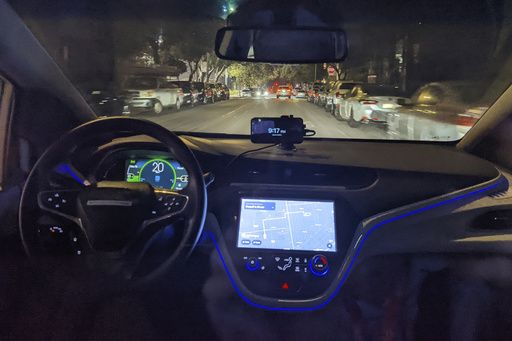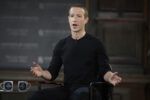Recalling a wild ride with a robotaxi named Peaches as regulators mull San Francisco expansion plan
FILE – The empty driver’s seat is shown in a driverless Chevy Bolt car named Peaches carrying Associated Press reporter Michael Liedtke during a ride in San Francisco, Sept. 13, 2022. The experience provided a snapshot of the often mysterious ways robotaxis have been malfunctioning in San Francisco, triggering a local backlash as state regulators prepare to vote on a proposed citywide expansion of the driverless vehicles on Thursday, Aug. 10, 2023. (AP Photo/Michael Liedtke, File)
SAN FRANCISCO (AP) — I won’t forget the first time I took a ride in a car without anyone sitting in the driver’s seat.
It happened one night last September when a Chevy Bolt named Peaches picked me up outside a San Francisco bar. Our ensuing half-hour ride together produced, at first, a titillating display of technology’s promise. Then an unexpected twist made me worry that the encounter had turned into a mistake I would regret.
Peaches and I were getting along great for most of our time together, as the car deftly navigated through hilly San Francisco streets similar to those Steve McQueen careened through during the famous chase scene in the 1968 film “Bullitt.” Unlike McQueen, Peaches never exceeded 30 mph (48 kph) because of restrictions imposed by state regulators on a ride-hailing service operated by Cruise, a General Motors subsidiary, since it won approval to transport fare-paying passengers last year.
It was all going so smoothly that I was starting to buy into the vision of Cruise and Waymo, a self-driving car pioneer spun off from a Google project that is also trying launch a ride-hailing service in San Francisco.
The theory fueling the ambition is that driverless cars will be safer than vehicles operated by frequently distracted and occasionally intoxicated humans — and, in the case of robotaxis, be less expensive and more convenient to ride in than automobiles that require a human behind the wheel.
The concept does sound good. And the technology to pull it off is advancing steadily, just like other artificial intelligence applications such as chatbots that can write college-level essays and produce impressive pieces of art within seconds.
But when something goes awry, as it did near the end of my encounter with Peaches, that sense of astonishment and delight can evaporate very quickly.
And even though none of the Cruise and Waymo driverless vehicles have been involved in major accidents in San Francisco, the robotaxis have been malfunctioning frequently enough to have triggered an intense resistance to proposed expansion that would allow them to operate around-the-clock throughout the city.
After postponing two previous votes on the proposed expansion in June and July amid the robotaxi backlash, the California Public Utilities Commission is scheduled to tackle the thorny issue Thursday — unless information presented at a Monday status conference prompts another delay.
DESTINATION: UNCERTAIN
My September ride with Peaches didn’t end well.
As we approached my designated drop-off location near the Fairmont Hotel — where presidents have stayed and the late Tony Bennett first sang “I Left My Heart In San Francisco” — Peaches advised me to gather my belongings and prepare to get out of the car.
While I grabbed my bag as the robotaxi appeared to be pulling over to the curb, it suddenly sped up and inexplicably started driving away in the opposite direction.
After seeing the dashboard display screen indicating I was now somehow an estimated 20 minutes away from my destination, I grew frantic. I asked Peaches what was going on. There was no response, so I used a feature on Cruise’s ride-hailing center that enables a passenger to contact a person at a call center.
The Cruise representative confirmed that Peaches had gotten confused, apologized and assured me the robotaxi had been reprogrammed to get me to my original destination.
Indeed, the car did seem to be headed back to where I requested. Then it started doing the old same thing again, making me wonder whether Peaches might like me a little too much to let me go. Feeling more like I was stuck on Mr. Toad’s Wild Ride at Disneyland than riding in an artificially intelligent car, I contacted Cruise’s call center. Peaches, they told me apologetically, seemed to be malfunctioning.
Suddenly, Peaches came to a halt right in the middle of the street. I bolted from the Bolt, marooned several blocks from my destination shortly before 10 p.m.
Fortunately, I know my way around San Francisco, so I walked the rest of the way to where I needed to be. But what if this had happened to tourists? Would they know where to go? How would they feel being forced to walk around a strange neighborhood in a big city late at night?
MAYBE DON’T STOP HERE
When I discussed the incident during an interview for a story about robotaxis, Cruise CEO Kyle Vogt apologized and assured me the problem had been fixed. Sure enough, I was picked up and dropped off at my designated destinations in rides I took in two different Cruise robotaxis — one named Cherry and the other Hollandaise — on a mid-February night in San Francisco.
Yet other problems apparently persist.
In the first five months of this year alone, city transportation officials said they logged reports of more than 240 incidents in which a Cruise or Waymo vehicle may have created a safety hazard. The transportation officials believe the actual number of problems may be even higher because state regulators don’t currently require Cruise or Waymo to disclose every incident involving erratic behavior in their respective fleets.
Cruise and Waymo contend that the problems cited by San Francisco officials have been overblown and are stepping up their efforts to counter the criticism.
In full-page ads that recently ran in several newspapers, Cruise declared, “Humans are terrible drivers,” while trumpeting its robotaxis as a safer alternative. And Waymo’s co-CEO Tekedra Mawakana recently wrote an opinion piece in the San Francisco Chronicle asserting that the company’s technology is “mature enough to make a meaningful impact on road safety.”
As for my night with Peaches? Whenever I reminisce about the ride, I am also reminded of another trip to New York that I took two days after the robotaxi couldn’t deliver me to my destination.
After I landed at JFK Airport, I hopped into an old-fashioned taxi driven by a fellow named Talid. I remember having a pleasant conversation with Talid, who chuckled as I recounted what happened with Peaches. At the end of the ride, Talid dropped me off at Grand Central Terminal, as I had requested. Then his cab drove off — with, of course, a human still behind the wheel.
Copyright 2023 The Associated Press. All rights reserved.


